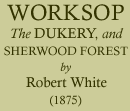< Previous | Contents | Next >
The town of Worksop is situated in a rich and gently sloping valley, in the north-west corner of Nottinghamshire, in the hundred of Basset-Lawe, on the border of Sherwood Forest. Its latitude is 53o 18' north, and 1o 9' west longitude.
The neighbourhood is agreeably diversified with woodland scenery and park-like landscapes. On approaching the town, from the Railway Station, the effect of the fine woods seen in the distance, extending over hundreds of acres south of the town, of the double-towered priory church in the valley, and of the new church of St. John’s in the foreground, is both striking and beautiful.
Worksop has no manufactures peculiar to itself, but the malting trade is carried on very extensively, and the direct access which the town has to the great manufacturing districts of Lancashire, renders it a most desirable locality for that business. There are now a great number of malt-kilns in and around the town, the cowls or hoods of which form a striking peculiarity in the scenery of the place. The amount of duty paid to the Excise for malt in the Worksop district is about £50,000 per annum. The principal markets for this article are Sheffield, Manchester, &c., &c. The town is famous for its flour, and it is admirably situated for carrying on a great trade in that article, as it is now connected by rails with districts to the eastward, unequalled for the extent of their agricultural productions, and it is thus convenient as a central mart between the growers and the consumers. The grinding of corn is just the species of manufacturing operation adapted for a clean and pretty market town in an agricultural district, and can neither detract from its agreeable aspect, nor render it unsuitable for the residence of families who wish to enjoy the pleasures of the country, particularly of retired manufacturers and tradesmen, who desire to terminate the labours of their youth and manhood in ease and repose. The timber trade has become an important business in the town of late years, and a considerable number of men are employed in preparing timber for railway purposes, and for the various departments of the Sheffield trade. Worksop has also long been famous for the manufacture of Windsor chairs.
The "Public Health Act, 1848," was applied to the town by a Provisional Order, dated February 6th, 1852, and in 1859-60 the Local Board of Health carried out a thorough system of sewerage and drainage at a cost of £6000. The system of sewerage was devised by Robert Rawlinson, Esq., C.E., C.B., and is considered one of the most efficient in England.
In 1866 the Local Board of Health was constituted a Burial Board for the parish of Worksop, and a Cemetery of about four acres was made adjoining the parish churchyard.
In 1801 the population of the parish was 3,263, and the following table will shew its increase to 1871:-
| 1801 | …. | 3,263 |
| 1811 | …. | 3,702 |
| 1821 | …. | 4,567 |
| 1831 | …. | 5,566 |
| 1851 | …. | 7,333 |
| 1861 | …. | 8,361 |
| 1871 | …. | 10,410 |
When the last census was taken, there were 5,305 males and 5,105 females in this parish, and it will be seen that the increase during the ten years was 2,049. The parish comprises 17,650 acres, and the population of the several townships comprised therein is as follows:-
| Worksop | 6,311 |
| Radford | 2,958 |
| Gateford | 220 |
| Haggonfield | 156 |
| Shireoaks | 572 |
| Osberton with Scofton | 178 |
| Hamlet of Kilton | 15 |
|
10,410 |
The rateable value of which is £55,185 11 10, and the ecclesiastical division is to
| The Parish Church | 5,844 |
| St. John’s Church | 3,829 |
| St. Luke’s, Shireoaks | 737 |
|
10,410 |
The town derives additional interest from the Manchester, Sheffield, and Lincolnshire Railway, and from the branch of the Midland Railway to Mansfield and Nottingham passing by it. The act for the former line passed the House of Lords, July 17, 1846, and the line was opened July 17, 1849.
